Serious Game iDO: Towards Better Education in Dementia Care
Abstract
:1. Introduction
2. Related Concepts on Serious Games
2.1. A Potential in Serious Games and Gamification
2.2. Serious Games in Health Care
3. Serious Game Design
3.1. Educational Model for Knowledge Transfer by iDO Gameplay
- To increase cognitive skills by teaching the concepts and principles of dementia care thus understanding differences among persons with various degrees of dementia and to demonstrate the ability of applying concepts to solve various real-life situations (via solving in-game problems), enhancing knowledge retention.
- To increase behavioral skills (care practice and development) to allow a more effective factual implementation of dementia care concepts, practical familiarization with problems, and outcomes and consequences through in-game decision making thus improving situational awareness, analysis, and decision skills.
- To increase skills to improve overall attitudes, motivation, and engagement towards dementia care not excluding the increase in overall job satisfaction.
3.2. Model of Game Mechanics
- Rest shows the tiredness rate of the person. This value is reduced over time and increases automatically when the person is resting. The reduction rate is increased when the person participates in activities, which increases the fun value.
- Hunger represents the character’s need for food. The value representing hunger is increased and reduced automatically whenever the person eats.
- The fun value shows the overall happiness and positive engagement of the game character. This value decreases over time. However, participating in fun activities increases the value.
- The social interaction value shows the need of a person for socialization. This value is increased when the person chats with the game character.
3.3. Model of Game User Experience (UX)
- Player Controller, also interacting with these activity entities, guides the Patient Character to do the activities associated with them and to interact with the activity entities.
- Character Creation Pawn presents the player with the character customization user interface and has a reference to the Patient Character to allow its customization.
- Game Pawn is controlled by the Player Controller and includes camera manipulation functions to allow the player to observe the game world from various points of view.
- Patient Character is the pawn that represents the patient that the caregiver has to look after. This pawn’s behavior is controlled by the AI Controller.
- AI Controller is driven by the AI system based on behavior trees in order to controls the Patient Character’s behavior.
- Activity Entities are objects in the game world, such as the couch on which the character can rest, and with which the player can interact with it during the gameplay.
4. Methods of Evaluation and Results
5. Discussion and Conclusions
Author Contributions
Funding
Acknowledgments
Conflicts of Interest
Ethics
References
- Yusif, S.; Soar, J.; Hafeez-Baig, A. Older people, assistive technologies, and the barriers to adoption: A systematic review. Int. J. Med. Inform. 2016, 94, 112–116. [Google Scholar] [CrossRef] [PubMed]
- Siegel, C.; Hochgatterer, A.; Dorner, T.E. Contributions of ambient assisted living for health and quality of life in the elderly and care services—A qualitative analysis from the experts’ perspective of care service professionals. BMC Geriatr. 2014, 14, 112. [Google Scholar] [CrossRef] [PubMed]
- World Alzheimer Report. The Global Impact of Dementia: An Analysis of Prevalence, Incidence, Cost and Trends; Alzheimer’s Disease International: London, UK, 2015. [Google Scholar]
- Hardy, C.J.; Marshall, C.R.; Golden, H.L.; Clark, C.N.; Mummery, C.J.; Griffiths, T.D.; Warren, J.D. Hearing and dementia. J. Neurol. 2016, 263, 2339–2354. [Google Scholar] [CrossRef] [PubMed]
- Desai, A.K.; Grossberg, G.T. Recognition and Management of Behavioral Disturbances in Dementia. Prim. Care Companion J. Clini. Psychiatry 2001, 3, 93–109. [Google Scholar] [CrossRef]
- Wiloth, S.; Werner, C.; Lemke, N.C.; Bauer, J.; Hauer, K. Motor-cognitive effects of a computerized game-based training method in people with dementia: A randomized controlled trial. J. Aging Ment. Health 2017, 22, 1–12. [Google Scholar] [CrossRef]
- Ido Game. Available online: http://idoproject.eu/game/ (accessed on 02 November 2019).
- Maskeliunas, R.; Damaševicius, R.; Blažauskas, T.; Paulauskas, A.; Paulauskas, L.; Chiatti, C. IDO: Modelling a serious educational game based on hands approach for training dementia carers. Int. J. Eng. Technol. 2018, 7, 143–146. [Google Scholar] [CrossRef]
- Deterding, S. Gamification: Designing for motivation. Interactions 2012, 19, 14–17. [Google Scholar] [CrossRef]
- Hamari, J.; Koivisto, J. Why do people use gamification services? Int. J. Inf. Manag. 2015, 35, 419–431. [Google Scholar] [CrossRef]
- Hamari, J.; Koivisto, J.; Sarsa, H. Does Gamification Work? A Literature Review of Empirical Studies on Gamification. In Proceedings of the 47th Hawaii International Conference on System Sciences (HICSS ’14), IEEE Computer Society, Washington, DC, USA, 6–9 January 2014; pp. 3025–3034. [Google Scholar] [CrossRef]
- Schoech, D.; Boyas, J.F.; Black, B.M.; Elias-Lambert, N. Gamification for Behavior Change: Lessons from Developing a Social, Multiuser, Web-Tablet Based Prevention Game for Youths. J. Technol. Hum. Serv. 2013, 31, 197–217. [Google Scholar] [CrossRef]
- Raziunaite, P.; Miliunaite, A.; Maskeliunas, R.; Damasevicius, R.; Sidekerskiene, T.; Narkeviciene, B. Designing an educational music game for digital game based learning: A Lithuanian case study. In Proceedings of the 2018 41st International Convention on Information and Communication Technology, Electronics and Microelectronics (MIPRO), Opatija, Croatia, 21–25 May 2018; pp. 800–805. [Google Scholar] [CrossRef]
- Damaševičius, R.; Narbutaite, L.; Plauska, I.; Blažauskas, T. Advances in the use of educational robots in project-based teaching. TEM J. 2017, 6, 342–348. [Google Scholar] [CrossRef]
- Silva, R.; Rodrigues, R.; Leal, C. Play it again: How game-based learning improves flow in Accounting and Marketing education. Account. Educ. 2019, 28, 484–507. [Google Scholar] [CrossRef]
- Ašeriškis, D.; Damaševičius, R. Gamification of a project management system. In Proceedings of the 7th International Conference on Advances in Computer-Human Interactions, Barcelona, Spain, 23–27 March 2014; pp. 200–207. [Google Scholar]
- Danevičius, E.; Maskeliunas, R.; Damaševičius, R.; Połap, D.; Wožniak, M. A soft body physics simulator with computational offloading to the cloud. Information 2018, 9, 318. [Google Scholar] [CrossRef]
- Boyle, E.A.; Hainey, T.; Connolly, T.M.; Gray, G.; Earp, J.; Ott, M.; Lim, T.; Ninaus, M.; Ribeiro, C.; Pereira, J. An update to the systematic literature review of empirical evidence of the impacts and outcomes of computer games and serious games. Comput. Educ. 2016, 94, 178–192. [Google Scholar] [CrossRef]
- Almeida, O.P.; Yeap, B.B.; Alfonso, H.; Hankey, G.J.; Flicker, L.; Norman, P.E. Older Men Who Use Computers Have Lower Risk of Dementia. PLoS ONE 2012, 7, e44239. [Google Scholar] [CrossRef] [PubMed]
- Petit dit Dariel, O.J.; Raby, T.; Ravaut, F.; Rothan-Tondeur, M. Developing the Serious Games potential in nursing education. Nurse Educ. Today 2013, 33, 1569–1575. [Google Scholar] [CrossRef]
- Romero, M. Work, Games and Lifelong Learning in the 21st Century. Proc. Soc. Behav. Sci. 2015, 174, 115–121. [Google Scholar] [CrossRef]
- Johnsen, H.M.; Fossum, M.; Vivekananda-Schmidt, P.; Fruhling, A.; Slettebø, Å. Developing a Serious Game for Nurse Education. J. Gerontol. Nurs. 2018, 44, 15–19. [Google Scholar] [CrossRef]
- Bellotti, F.; Kapralos, B.; Lee, K.; Moreno-Ger, P.; Berta, R. Assessment in and of Serious Games: An Overview. Adv. Hum. Comput. Interact. 2013, 2013, 136864. [Google Scholar] [CrossRef]
- Laamarti, F.; Eid, M.; El Saddik, A. An Overview of Serious Games. Int. J. Comput. Games Technol. 2014, 2014, 358152. [Google Scholar] [CrossRef]
- Manera, V.; Brousse, J.; Foulon, P.; Deudon, A.; Leone, E.; David, R.; Robert, P. Neuropsychiatric symptoms in dementia. How serious games can improve caregiver’s education. Innov. Glob. Health Prof. Educ. 2016. [Google Scholar] [CrossRef]
- Verkuyl, M.; Romaniuk, D.; Atack, L.; Mastrilli, P. Virtual Gaming Simulation for Nursing Education: An Experiment. Clin. Simul. Nurs. 2017, 13, 238–244. [Google Scholar] [CrossRef]
- Pront, L.; Müller, A.; Koschade, A.; Hutton, A. Gaming in Nursing Education: A Literature Review. Nurs. Educ. Perspect. 2018, 39, 23–28. [Google Scholar] [CrossRef] [PubMed]
- McCallum, S.; Boletsis, C. Dementia Games. In Serious Games Development and Applications; Ma, M., Oliveira, M.F., Petersen, S., Hauge, J.B., Eds.; Springer: Berlin, Germany, 2013; pp. 15–27. [Google Scholar]
- Zheng, J.; Chen, X.; Yu, P. Game-based interventions and their impact on dementia: A narrative review. Aust. Psychiatry 2017, 25, 562–565. [Google Scholar] [CrossRef]
- Tan, A.J.Q.; Lau, C.C.S.; Liaw, S.Y. Serious games in nursing education: An integrative review. In Proceedings of the 9th International Conference on Virtual Worlds and Games for Serious Applications (VS-Games), Athens, Greece, 6–8 September 2017. [Google Scholar] [CrossRef]
- Padilha, J.M.; Machado, P.P.; Ribeiro, A.; Ramos, J.; Costa, P. Clinical Virtual Simulation in Nursing Education: Randomized Controlled Trial. J. Med. Internet Res. 2019, 21, e11529. [Google Scholar] [CrossRef] [PubMed]
- Mili, F.; Barr, J.; Harris, M.; Pittiglio, L. Nursing Training: 3D Game with Learning Objectives. In Proceedings of the First International Conference on Advances in Computer-Human Interaction, Sainte Luce, Martinique, 10–15 February 2018. [Google Scholar]
- Cook, N.F.; McAloon, T.; O’Neill, P.; Beggs, R. Impact of a web based interactive simulation game (PULSE) on nursing students’ experience and performance in life support training—A pilot study. Nurse Educ. Today 2012, 32, 714–720. [Google Scholar] [CrossRef]
- Tresser, S. Case Study: Using a Novel Virtual Reality Computer Game for Occupational Therapy Intervention. Teleoperators Virtual Environ. 2012, 21, 359–371. [Google Scholar] [CrossRef]
- Johnsen, H.M.; Fossum, M.; Vivekananda-Schmidt, P.; Fruhling, A.; Slettebø, Å. A Serious Game for Teaching Nursing Students Clinical Reasoning and Decision-Making Skills. Stud. Health Technol. Inform. 2016, 225, 905–906. [Google Scholar] [CrossRef]
- Sisarica, A.; Maiden, N.; Morosini, D.; Panesse, L.; Pudney, K.; Rose, M. Creativity support in a serious game for dementia care. In Proceedings of the 9th ACM Conference on Creativity & Cognition—C&C ’13, Sydney, Australia, 17–20 June 2013. [Google Scholar]
- Wehbe-Alamah, H.; Farmer, M.E.; McFarland, M.; Tower, A.; Jones, M.; Shah, V.; El-Hayek, J. Development of an extensible game architecture for teaching transcultural nursing. Online J. Cult. Competence Nurs. Healthc. 2015, 5, 64–74. [Google Scholar] [CrossRef]
- Patel, R.; Salata, A. Using computer games to mediate caregiver-child communication for children with severe dysarthria. J. Med. Speech 2006, 14, 279–284. [Google Scholar]
- James, S.; Ziviani, J.; King, G.; Boyd, R.N. Understanding Engagement in Home-Based Interactive Computer Play: Perspectives of Children with Unilateral Cerebral Palsy and Their Caregivers. Phys. Occup. Ther. Pediatr. 2015, 36, 343–358. [Google Scholar] [CrossRef]
- Vidani, A.C.; Chittaro, L.; Carchietti, E. Assessing Nurses’ Acceptance of a Serious Game for Emergency Medical Services. In Proceedings of the 2nd International Conference on Games and Virtual Worlds for Serious Applications (VS-GAMES 2010), Braga, Portugal, 25–26 March 2010. [Google Scholar]
- Wingham, J.; Adie, K.; Turner, D.; Schofield, C.; Pritchard, C. Participant and caregiver experience of the Nintendo Wii SportsTM after stroke: Qualitative study of the trial of WiiTM in stroke (TWIST). Clin. Rehabil. 2014, 29, 295–305. [Google Scholar] [CrossRef] [PubMed]
- Xu, Q.; Chen, L.; Zhu, T.; Xu, Y. Assessing the Effect of Game System for Rehabilitation on Rehabilitation of Autism and Cerebral Palsy. MATEC Web Conf. 2015, 22, 1023. [Google Scholar] [CrossRef]
- Tak, S.H.; Beck, C.; Hong, S.H. Feasibility of providing computer activities for nursing home residents with dementia. Non Pharmacol. Ther. Dement. 2013, 3, 1–10. [Google Scholar]
- Tong, T.; Chan, J.H.; Chignell, M. Serious Games for Dementia. In Proceedings of the 26th International Conference on World Wide Web Companion—WWW ’17 Companion, Perth, Australia, 3–7 April 2017. [Google Scholar]
- Mubin, O.; Shahid, S.; Abdullah Al Mahmud, A. Walk 2 Win: Towards designing a mobile game for elderly’s social engagement. In Proceedings of the 22nd British HCI Group Annual Conference on People and Computers: Culture, Creativity, Interaction—Volume 2 (BCS-HCI ’08), Liverpool, UK, 1–5 September 2008. [Google Scholar]
- Vallejo, V.; Tarnanas, I.; Yamaguchi, T.; Tsukagoshi, T.; Yasuda, R.; Müri, R.M.; Mosimann, U.P.; Nef, T. Usability assessment of natural user interfaces during serious games: Adjustments for dementia intervention. J. Pain Manag. 2016, 9, 333–339. [Google Scholar]
- Sardi, L.; Idri, A.; Fernández-Alemán, J.L. A systematic review of gamification in e-Health. J. Biomed. Inf. 2017, 71, 31–48. [Google Scholar] [CrossRef]
- Wiemeyer, J.; Kliem, A. Serious games in prevention and rehabilitation—A new panacea for elderly people? Eur. Rev. Aging Phys. Act. 2011, 9, 93. [Google Scholar] [CrossRef] [Green Version]
- Elaachak, L.; Belahbib, A.; Bouhorma, M. A digital revolution in Nursing Education—The serious games. In Proceedings of the 2016 5th Int. Conference on Multimedia Computing and Systems (ICMCS), Marrakech, Morocco, 29 September–1 October 2016; pp. 705–709. [Google Scholar]
- Cant, R.P.; Cooper, S.J. Simulation-based learning in nurse education: Systematic review. J. Adv. Nurs. 2010, 66, 3–15. [Google Scholar] [CrossRef]
- Ranchhod, A.; Gurău, C.; Loukis, E.; Trivedi, R. Evaluating the educational effectiveness of simulation games: A value generation model. Inf. Sci. 2014, 264, 75–90. [Google Scholar] [CrossRef]
- Ašeriškis, D.; Damaševičius, R. Gamification Patterns for Gamification Applications. Procedia Comput. Sci. 2014, 39, 83–90. [Google Scholar] [CrossRef] [Green Version]
- Dormans, J. The Effectiveness and Efficiency of Model Driven Game Design. In Proceedings of the 11th international conference on Entertainment Computing (ICEC’12), Bremen, Germany, 26–29 September 2012; pp. 542–548. [Google Scholar]
- Carpenter, B.D.; Xiong, C.; Porensky, E.K.; Lee, M.M.; Brown, P.J.; Coats, M.; Johnson, D.; Morris, J.C. Reaction to a dementia diagnosis in individuals with Alzheimer’s disease and mild cognitive impairment. J. Am. Geriatr. Soc. 2008, 56, 405–412. [Google Scholar] [CrossRef]
- Yesavage, J.A.; Brink, T.L.; Rose, T.L.; Lum, O.; Huang, V.; Adey, M.; Leirer, V.O. Development and validation of a geriatric depression screening scale: A preliminary report. J. Psychiatr. Res. 1982, 17, 37–49. [Google Scholar] [CrossRef]
- O’Connor, M.L.; McFadden, S.H. Development and Psychometric Validation of the Dementia Attitudes Scale. Int. J. Alzheimer Dis. 2010, 2010, 454218. [Google Scholar] [CrossRef] [Green Version]
- Brooke, J. SUS-A quick and dirty usability scale. Usab. Eval. Ind. 1996, 189, 4–7. [Google Scholar]
- Derrick, B.; White, P. Comparing Two Samples from an Individual Likert Question. Int. J. Math. Stat. 2017, 18, 1–13. [Google Scholar]
- Dietlein, C.; Bock, O. Usability of serious games for the training of people with dementia. EAI Endorsed Trans. Game Based Learn. 2018, 2018, 159946. [Google Scholar] [CrossRef]
- Mortara, M.; Catalano, C.E.; Fiucci, G.; Derntl, M. Evaluating the Effectiveness of Serious Games for Cultural Awareness: The Icura User Study. In International Conference on Games and Learning Alliance; De Gloria, A., Ed.; Springer: Cham, Switzerland, 2013. [Google Scholar]
- Phillipson, L.; Goodenough, B.; Reis, S.; Fleming, R. Applying Knowledge Translation Concepts and Strategies in Dementia Care Education for Health Professionals: Recommendations from a Narrative Literature Review. J. Contin. Educ. Health Prof. 2016, 36, 74–81. [Google Scholar] [CrossRef]
- Manera, V.; Petit, P.D.; Derreumaux, A.; Orvieto, I.; Romagnoli, M.; Lyttle, G.; David, R.; Robert, P.H. ‘Kitchen and cooking’, a serious game for mild cognitive impairment and Alzheimer’s disease: A pilot study. Front. Aging Neurosci. 2015, 7, 24. [Google Scholar] [CrossRef]
- Surr, C.A.; Smith, S.J.; Crossland, J.; Robins, J. Impact of a person-centred dementia care training programme on hospital staff attitudes, role efficacy and perceptions of caring for people with dementia: A repeated measures study. Int. J. Nurs. Stud. 2016, 53, 144–151. [Google Scholar] [CrossRef]
- Chiao, C.Y.; Wu, H.S.; Hsiao, C.Y. Caregiver burden for informal caregivers of patients with dementia: A systematic review. Int. Nurs. Rev. 2015, 62, 340–350. [Google Scholar] [CrossRef]
- Astell, A.J.; Bouranis, N.; Hoey, J.; Lindauer, A.; Mihailidis, A.; Nugent, C.; Robillard, J.M. Technology and Dementia: The Future is Now. Dement. Geriatr. Cognit. Disord. 2019, 47, 131–139. [Google Scholar] [CrossRef] [Green Version]
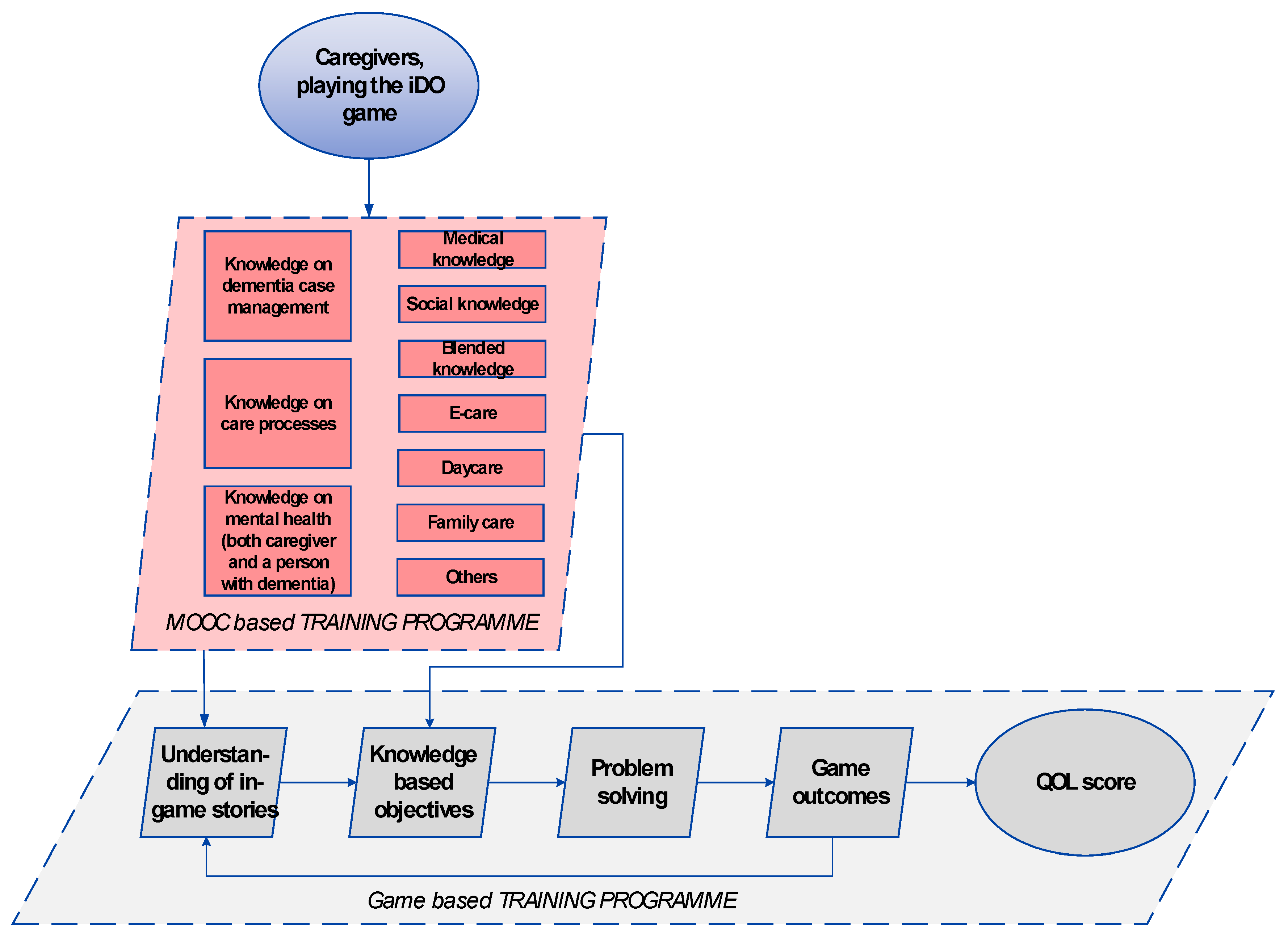
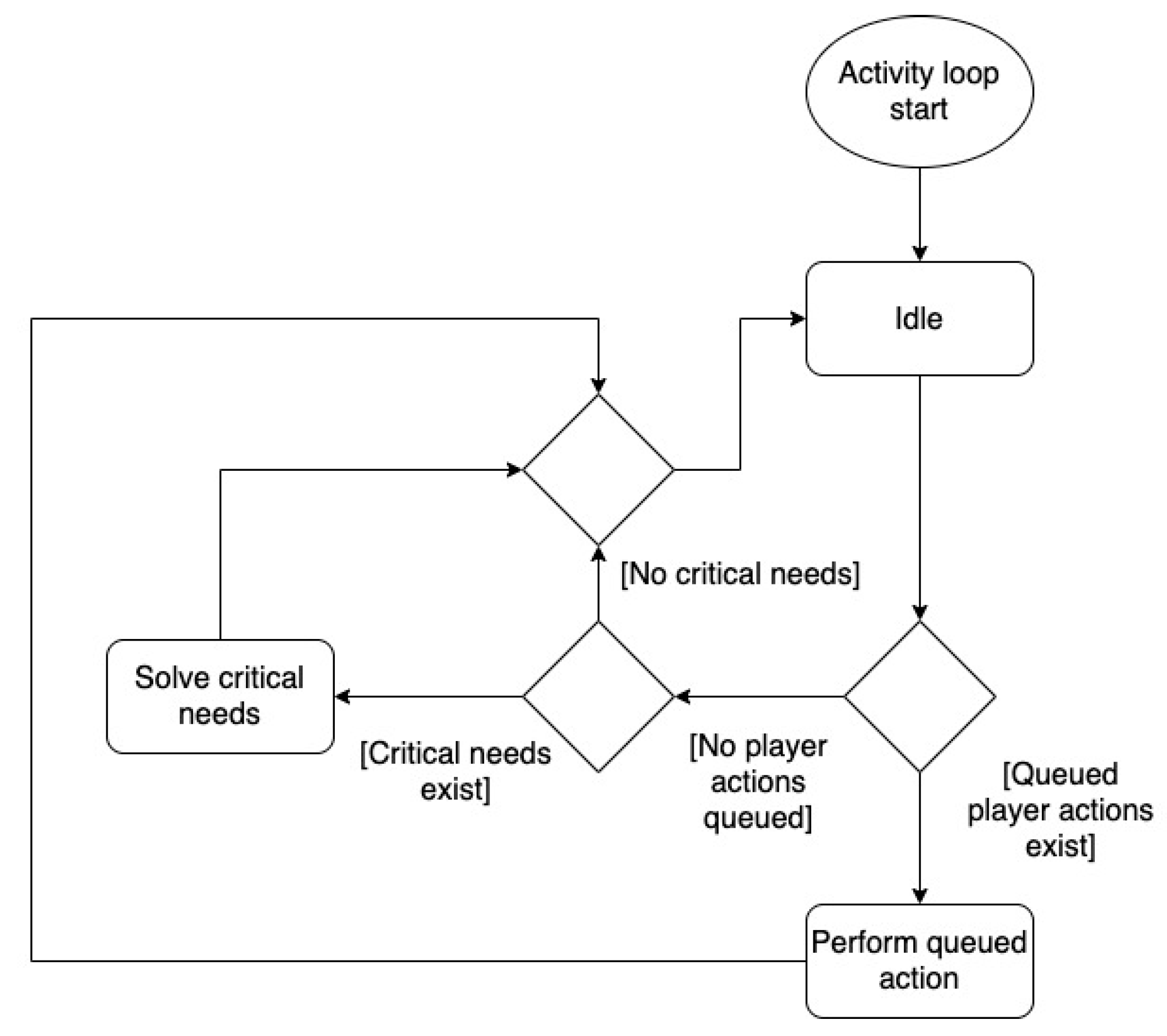
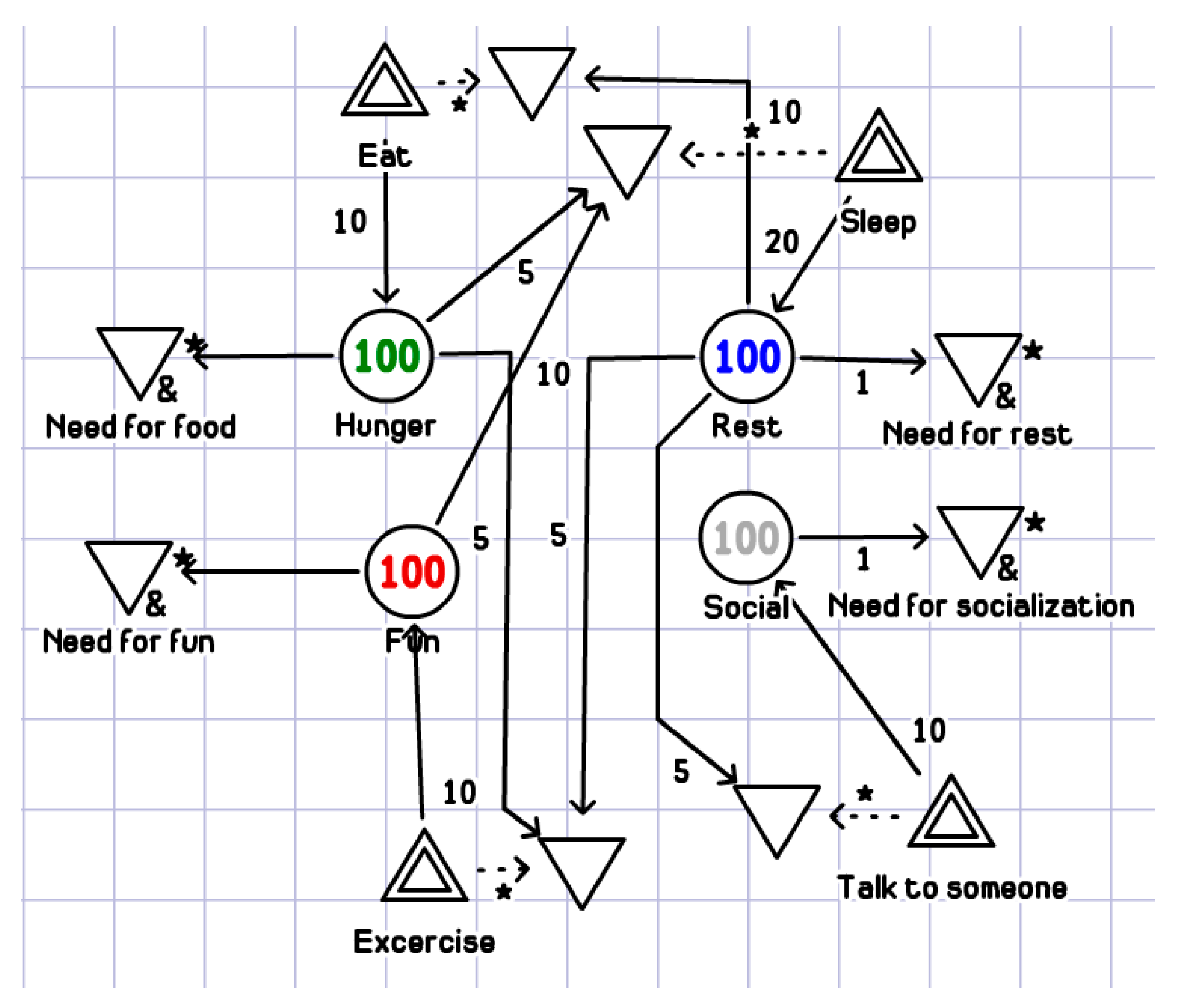
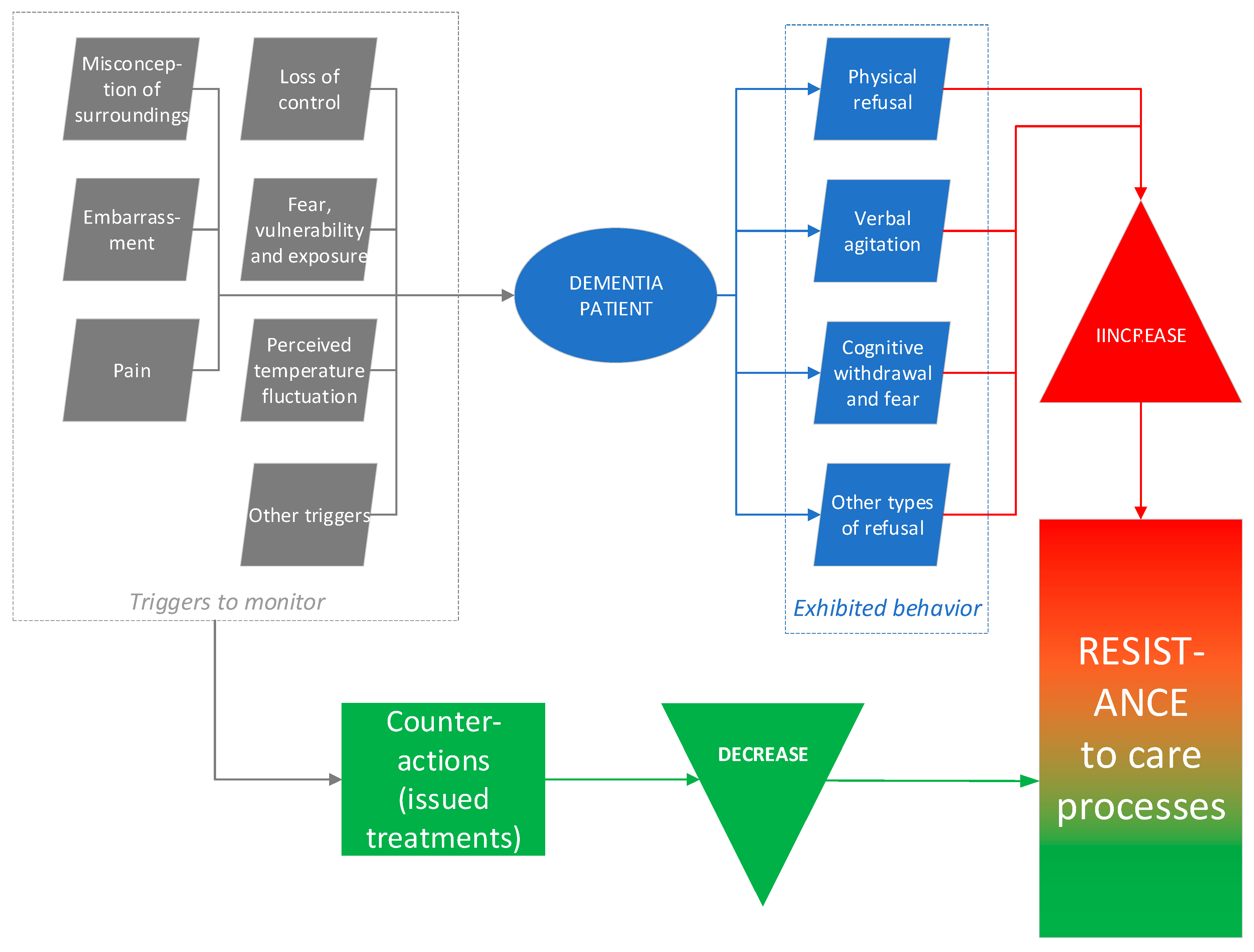
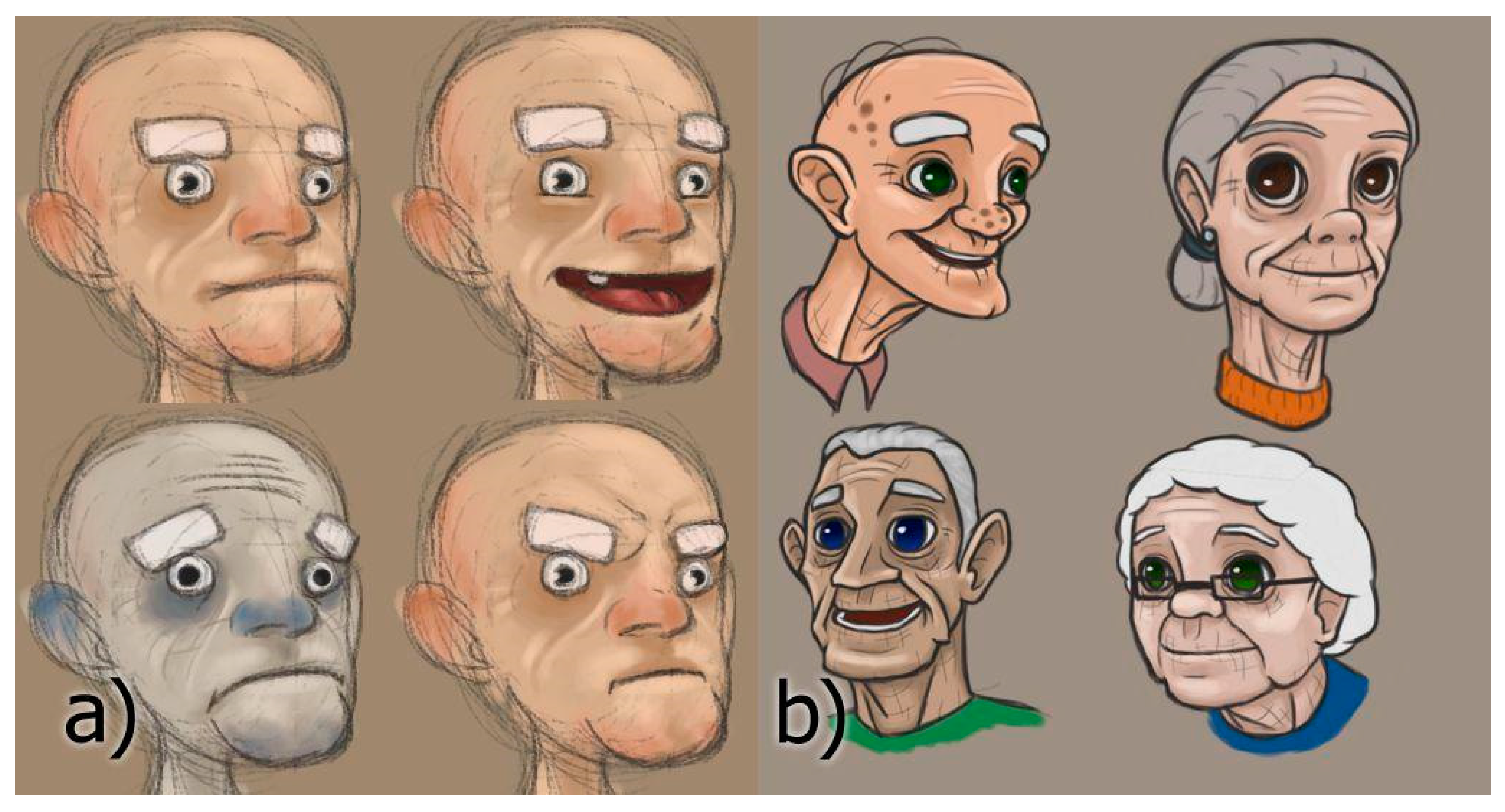
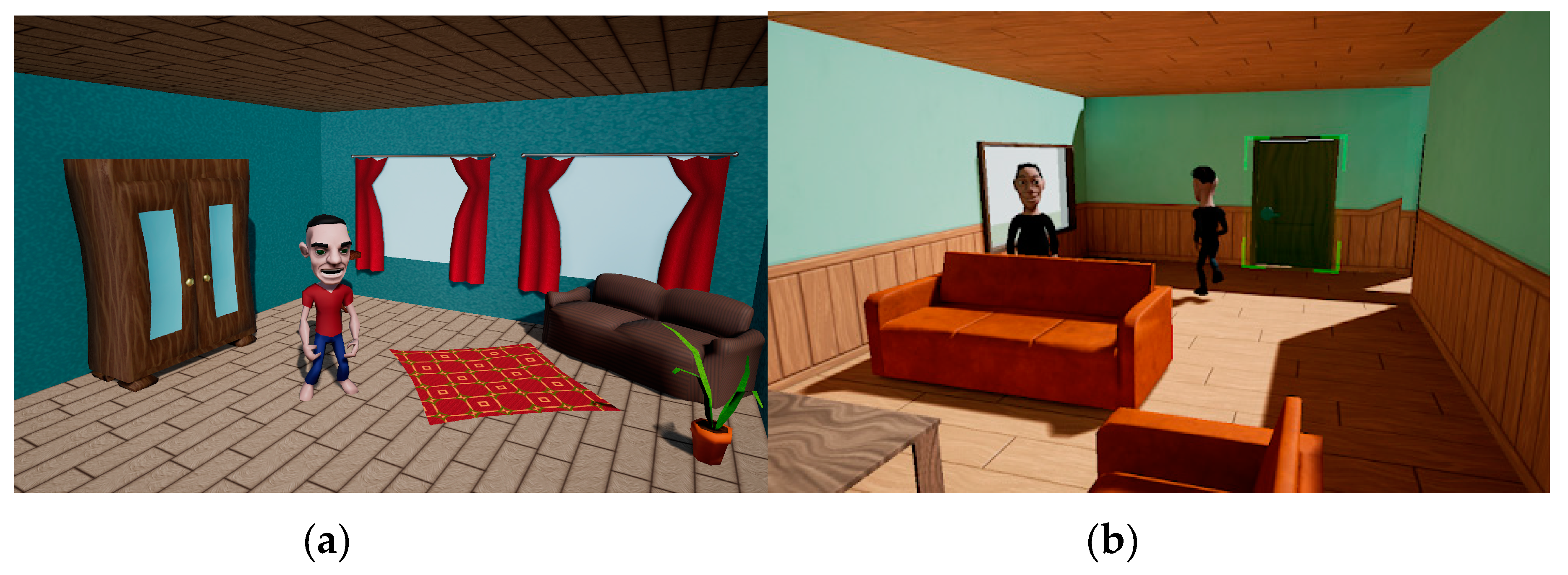
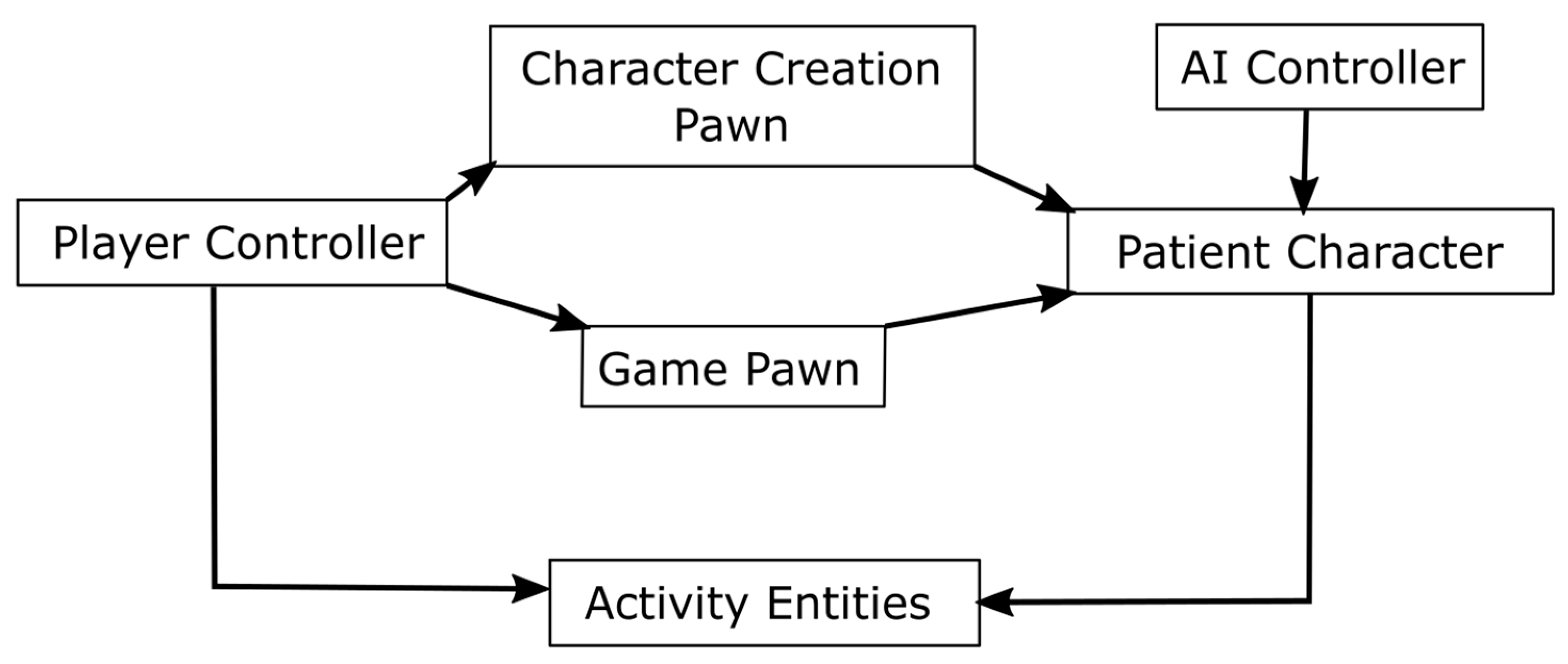
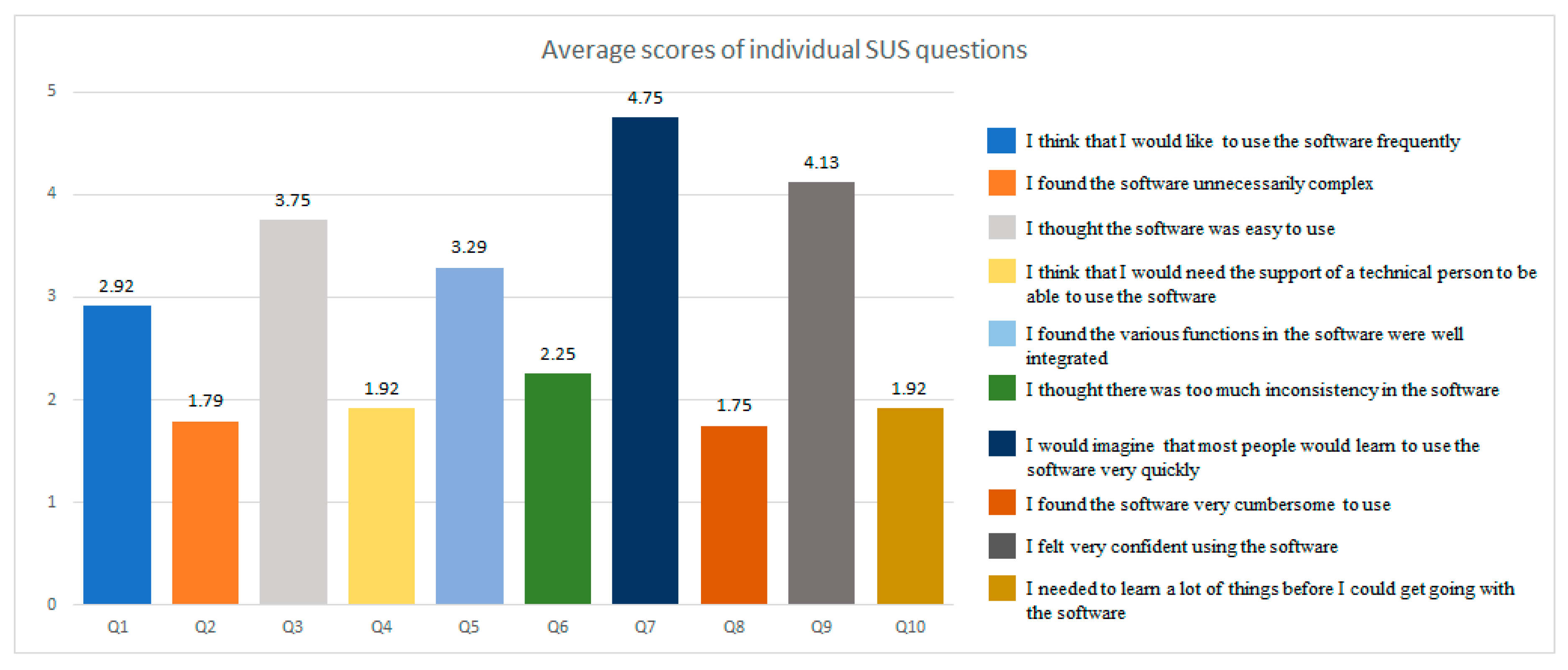

© 2019 by the authors. Licensee MDPI, Basel, Switzerland. This article is an open access article distributed under the terms and conditions of the Creative Commons Attribution (CC BY) license (http://creativecommons.org/licenses/by/4.0/).
Share and Cite
Maskeliūnas, R.; Damaševičius, R.; Lethin, C.; Paulauskas, A.; Esposito, A.; Catena, M.; Aschettino, V. Serious Game iDO: Towards Better Education in Dementia Care. Information 2019, 10, 355. https://doi.org/10.3390/info10110355
Maskeliūnas R, Damaševičius R, Lethin C, Paulauskas A, Esposito A, Catena M, Aschettino V. Serious Game iDO: Towards Better Education in Dementia Care. Information. 2019; 10(11):355. https://doi.org/10.3390/info10110355
Chicago/Turabian StyleMaskeliūnas, Rytis, Robertas Damaševičius, Connie Lethin, Andrius Paulauskas, Anna Esposito, Mauro Catena, and Vincenzo Aschettino. 2019. "Serious Game iDO: Towards Better Education in Dementia Care" Information 10, no. 11: 355. https://doi.org/10.3390/info10110355




